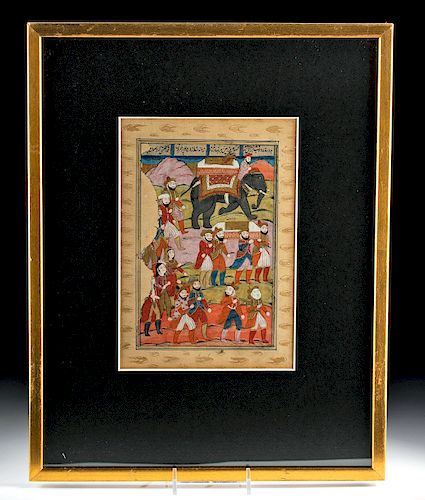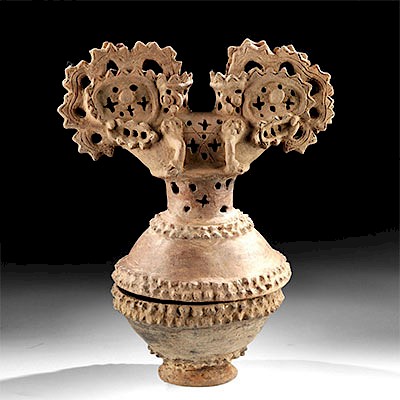Framed 18th C. Mughal Painting of Funeral Procession
Lot 51
About Seller
Artemis Gallery
686 S Taylor Ave, Ste 106
Louisville, CO 80027
United States
Selling antiquities, ancient and ethnographic art online since 1993, Artemis Gallery specializes in Classical Antiquities (Egyptian, Greek, Roman, Near Eastern), Asian, Pre-Columbian, African / Tribal / Oceanographic art. Our extensive inventory includes pottery, stone, metal, wood, glass and textil...Read more
Estimate:
$1,200 - $1,800
Absentee vs Live bid
Two ways to bid:
- Leave a max absentee bid and the platform will bid on your behalf up to your maximum bid during the live auction.
- Bid live during the auction and your bids will be submitted real-time to the auctioneer.
Bid Increments
| Price | Bid Increment |
|---|---|
| $0 | $25 |
| $300 | $50 |
| $1,000 | $100 |
| $2,000 | $250 |
| $5,000 | $500 |
| $10,000 | $1,000 |
| $20,000 | $2,500 |
| $50,000 | $5,000 |
| $100,000 | $10,000 |
| $200,000 | $20,000 |
About Auction
By Artemis Gallery
Aug 22, 2019
Set Reminder
2019-08-22 10:00:00
2019-08-22 10:00:00
America/New_York
Bidsquare
Bidsquare : Fine Ancient | Asian | Ethnographic Art
https://www.bidsquare.com/auctions/artemis-gallery/fine-ancient-asian-ethnographic-art-4348
Featuring classical antiquities, ancient and ethnographic art from cultures encompassing the globe, plus fine art. Egyptian, Greek, Roman, Etruscan, Near Eastern, Asian, Pre-Columbian, Native American, African / Tribal, Oceanic, Spanish Colonial, Russian, Fine Art, so much more! Artemis Gallery info@artemisgallery.com
Featuring classical antiquities, ancient and ethnographic art from cultures encompassing the globe, plus fine art. Egyptian, Greek, Roman, Etruscan, Near Eastern, Asian, Pre-Columbian, Native American, African / Tribal, Oceanic, Spanish Colonial, Russian, Fine Art, so much more! Artemis Gallery info@artemisgallery.com
- Lot Description
Central Asia, India, possibly Gujarat or Kashmir, Mughal Period, ca. 18th or 19th century CE. Finely delineated in tempera and gold leaf on handmade paper with calligraphic script at the top, a miniature painting of a funeral procession of a royal or hero - perhaps the Persian hero Rustam (also Rostam). The composition includes three rows of mourners dressed in fine garments and headdresses. Leading the procession is an elaborately adorned elephant carrying a coffin with a golden zoomorphic ornament atop. Size: 8.875" L x 6.125" W (22.5 cm x 15.6 cm); 16.25" L x 12.5" W (41.3 cm x 31.8 cm) framed
The Mughals, Islamic dynasty rulers of northern India between 1526 and 1857, were known for their great patronage of the arts. Artists created intricate paintings and illuminated manuscripts depicting scenes of daily life, adventurous tales, mythological and royalty scenes like these. The compositions are beautifully balanced and finely painted in rich tones.
Miniature painting emerged in Persian art during the 13th century. Following the Mongol conquests, the genre displayed strong Chinese influence, and the tradition reached its peak during the 15th and 16th centuries. Furthermore, Persian miniature painting influenced other Islamic miniature traditions, including the Ottoman miniature created in Turkey as well as the Mughal miniature of India.
Mughal painting refers to a type of miniature painting - either serving as book illustrations or created as single work. The term miniature suggests a tiny scale; however, it actually indicates a style of watercolor work similar to early European book illustrations that used the red pigment minia. Some Indian miniatures are in fact quite large. The Mughal style stems from Persian miniature painting, though with Indian Hindu, Jain, and Buddhist influences, evolving largely throughout the Mughal Empire (16th to 19th centuries), and eventually spreading to other Indian courts - Muslim, Hindu, and Sikh - flourishing during the reigns of Akbar, Shah Jahan, and Jahangir. The tradition continues today with Mughal-style miniature paintings still being created, though only by a relatively small number of artists in Rajasthan.
Provenance: private Hawaii, USA collection
All items legal to buy/sell under U.S. Statute covering cultural patrimony Code 2600, CHAPTER 14, and are guaranteed to be as described or your money back.
A Certificate of Authenticity will accompany all winning bids.
We ship worldwide and handle all shipping in-house for your convenience.
#148339Some losses to left side of the composition as shown. Otherwise the painting is very strong with vivid pigments and details. Nicely framed.Condition
- Shipping Info
-
All shipping is handled in-house for your convenience. Your invoice from Artemis Gallery will include shipping calculation instructions. If in doubt, please inquire BEFORE bidding for estimated shipping costs for individual items.
-
- Buyer's Premium



 EUR
EUR CAD
CAD AUD
AUD GBP
GBP MXN
MXN HKD
HKD CNY
CNY MYR
MYR SEK
SEK SGD
SGD CHF
CHF THB
THB














